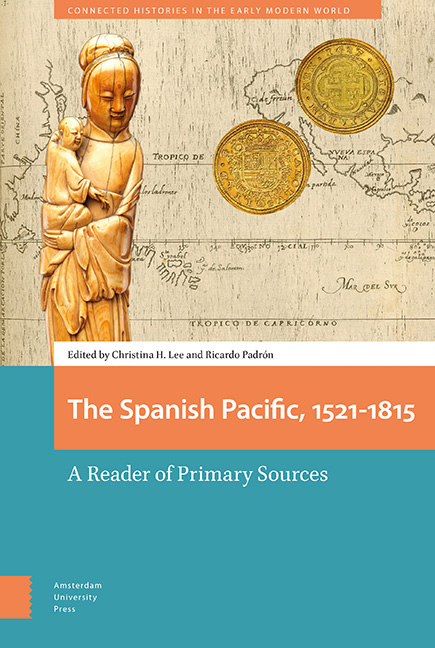Book contents
- Frontmatter
- Contents
- Abbreviations
- Acknowledgements
- Introduction
- 1 An Early Transpacific Account of the Spice Islands by Andrés de Urdaneta (1536)
- 2 Domingo de Salazar’s Letter to the King of Spain in Defense of the Indians and the Chinese of the Philippine Islands (1582)
- 3 Juan Cobo’s Map of the Pacific World (1593)
- 4 A Royal Decree of Philip III Regulating Trade between the Philippines and New Spain (1604)
- 5 Manila’s Sangleys and a Chinese Wedding (1625)
- 6 Don Luis Castilla Offers to Sell Land in Manila (1629)
- 7 Idolatry and Apostasy in the 1633 Jesuit Annual Letter
- 8 The Will of an Indian Oriental and her Chinos in Peru (1644
- 9 Francisco de Combés’s History of Mindanao and Jolo (1667)
- 10 Between Fiction and History in the Spanish Pacific The Misfortunes of Alonso Ramírez (1690)
- 11 A Moluccan Crypto-Muslim before the Transpacific Inquisition (1623–1645)
- 12 Constitutions and Rules of the Beatas Indias (1726)
- 13 The Poetics of Praise and the Demands of Confession in the Early Spanish Philippines: Notes and Documents
- 14 The Pacific Theater of the Seven Years’ War in a Latin Poem by an Indigenous Priest, Bartolomé Saguinsín (1766)
- 15 A Prohibition on Digging Up the Bones of the Dead (1813)
- Index
3 - Juan Cobo’s Map of the Pacific World (1593)
Published online by Cambridge University Press: 20 November 2020
- Frontmatter
- Contents
- Abbreviations
- Acknowledgements
- Introduction
- 1 An Early Transpacific Account of the Spice Islands by Andrés de Urdaneta (1536)
- 2 Domingo de Salazar’s Letter to the King of Spain in Defense of the Indians and the Chinese of the Philippine Islands (1582)
- 3 Juan Cobo’s Map of the Pacific World (1593)
- 4 A Royal Decree of Philip III Regulating Trade between the Philippines and New Spain (1604)
- 5 Manila’s Sangleys and a Chinese Wedding (1625)
- 6 Don Luis Castilla Offers to Sell Land in Manila (1629)
- 7 Idolatry and Apostasy in the 1633 Jesuit Annual Letter
- 8 The Will of an Indian Oriental and her Chinos in Peru (1644
- 9 Francisco de Combés’s History of Mindanao and Jolo (1667)
- 10 Between Fiction and History in the Spanish Pacific The Misfortunes of Alonso Ramírez (1690)
- 11 A Moluccan Crypto-Muslim before the Transpacific Inquisition (1623–1645)
- 12 Constitutions and Rules of the Beatas Indias (1726)
- 13 The Poetics of Praise and the Demands of Confession in the Early Spanish Philippines: Notes and Documents
- 14 The Pacific Theater of the Seven Years’ War in a Latin Poem by an Indigenous Priest, Bartolomé Saguinsín (1766)
- 15 A Prohibition on Digging Up the Bones of the Dead (1813)
- Index
Summary
Abstract
Juan Cobo (1546/47–1592) was a Dominican priest who devoted most of his efforts in the Philippines to proselytizing the resident Chinese population of Manila and its environs. This map of the Pacific world from China to Mexico appears in a translation of an influential piece of Counter-Reformation apologetics that Cobo prepared with the help, most likely, of unnamed Chinese collaborators, and that he had published in Manila in 1593 for the benefit of Chinese prospects for Christian conversion. It is the first European-style map created for a Chinese reader. Timothy Brook provides an English translation of the map's Chinese inscriptions, while Ricardo Padrón analyzes the map's rhetorical position.
Keywords: colonial cartography; sangleys; early publishing in the Philippines; Christian apologetics
The map below appeared in one of the first printed works to be produced in Spanish Manila, Juan Cobo's Bian zhengjiao zhenchuan shilu 辨正教 真传实录 (Apology for the True Religion)—published in 1593—and was often referred to simply as the Shilu 实录. Produced on fragile rice paper, it survives in a single copy held by the Madrid's Biblioteca Nacional. Its author, Juan Cobo (1546/47–1592) was a Spanish Dominican friar trained at the Convent of Santo Tomas in the Castilian city of Ávila and at the University of Alcalá who arrived in the Philippines in 1588, to proselytize Manila's Sangleys, as the members of the resident Chinese population were known. Enjoying a reputation as a master of the Chinese language, albeit only among people who did not themselves speak Chinese, Cobo was responsible for several translations of religious and philosophical works from Spanish into Chinese and from Chinese into Spanish. Among them is the Shilu, a Chinese rendering of part of Fray Luis de Granada's Introduction to the Symbol of Faith (Introducción al símbolo de la fe; Salamanca, 1584), a significant work of Catholic apologetics written in response to the challenge posed by the Protestant Reformation. Anticipating the work of the Jesuit Matteo Ricci, Cobo mixes early modern science into his religious and philosophical stew, dealing briefly with astronomy, geography, botany, and zoology. The map appears in the fourth chapter and answers to the long-standing Chinese tradition of mapping the world as a square with China at the center.
- Type
- Chapter
- Information
- Spanish Pacific, 1521–1815A Reader of Primary Sources, pp. 53 - 60Publisher: Amsterdam University PressPrint publication year: 2020



